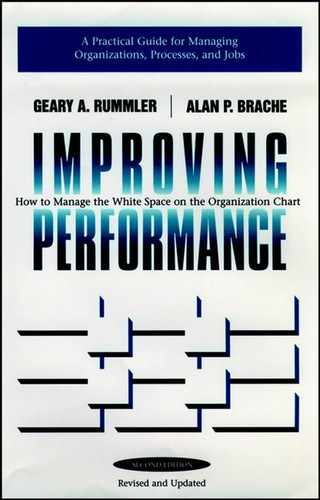4.4. Summary
If the Organization Level of Performance is not being defined, designed, and managed, there is no context for or driver of human and system performance. In this environment, well-intentioned activities are carried out in a vacuum and are frequently off the mark. Considerations related to the Organization Level are important to any organizational unit, from an entire company or agency to the smallest subdepartment. Variables and tools concerned with the Organization Level can be used by:
Executives, to understand how the business operates, to refine the organization strategy and measures, to establish appropriate departmental relationships, to create a workable organization structure, and to manage the interfaces among departments
Managers, to understand how their businesses operate and how they fit into the big picture, to establish department goals, to strengthen relationships with other departments, to create a workable organization structure, and to manage the interfaces among subunits within their departments
Analysts, to understand how their client organizations currently operate and how they measure results, to identity areas where their efforts will have the greatest payoffs, to determine the impact of system changes and other proposed improvements on the organization as a whole, and to recommend enhancements that will have a positive effect on organizationwide performance
By answering questions such as those listed for each of the three Performance Variables at the Organization Level, and by using tools such as the Relationship Map, one can guide organization performance and bring it under control. This chapter began with a bleak scenario involving customers, suppliers, employees, and shareholders. Effective management of the Organization Level can go a long way toward converting those viewpoints.
The Customer's View of the Organization. "These people are highly responsive to our needs. They frequently know what we want and need before we do. While their product is good, what keeps us coming back is the after-sale service. They don't promise what they can't deliver. We have establish ed a solid, long-term relationship with our account executive. We're proud to have them as a vendor."
The Supplier's View of the Organization. 'These people appear to know where they're going. They give us plenty of lead time when they need parts for a new or modified product. They enforce especially tight specifications on those dimensions of our parts that contribute to their competitive edges. And they include us in the process of developing their competitive edges. Because they treat us as a business partner, we'll go the extra mile for them. We're proud to be their vendor."
The Employees' View of the Organization. "Everyone in this organization takes responsibility for doing the job right the first time. We can't afford any mistakes. Before they promise a modified product or a nonstandard delivery schedule to a customer, sales talks to product development, manufacturing, and distribution. I can reach fairly quick agreement with other departments because we all understand the interdependencies and the priorities necessary to keep our customers coming back. Products are developed by a team com posed of marketing, manufacturing, and product development. Meetings are frequently attended by customers and prospects. Every employee knows the strategy of the company and how his or her goals contribute to that strategy. I understand my priorities. When they change, I know why. People realize that their role is to serve the needs of internal or external customers. Section managers know that they will not achieve their goals if they don't cooperate with the sections that serve as their suppliers and customers. I am motivated by the challenge provided by my job and by the support I am given. I realize that I am a critical link in the chain. I'm proud to work here."
The Shareholders' View of the Organization. "This company is making me money."
Utopia? Not in our experience. These prevailing views are the natural result of an organization that "has its act together" at each of the Three Levels of Performance, and it all starts at the Organization Level. The Performance Variables and Tools at the Organization Level help identify what needs to get done (goals), the relationships necessary to get it done (design), and the practices that remove the impediments to getting it done (management). With an effective Organization Level as a foundation, we can begin to understand, analyze, and manage performance at the Process and Job/Performer Levels, which are covered in the next two chapters.
